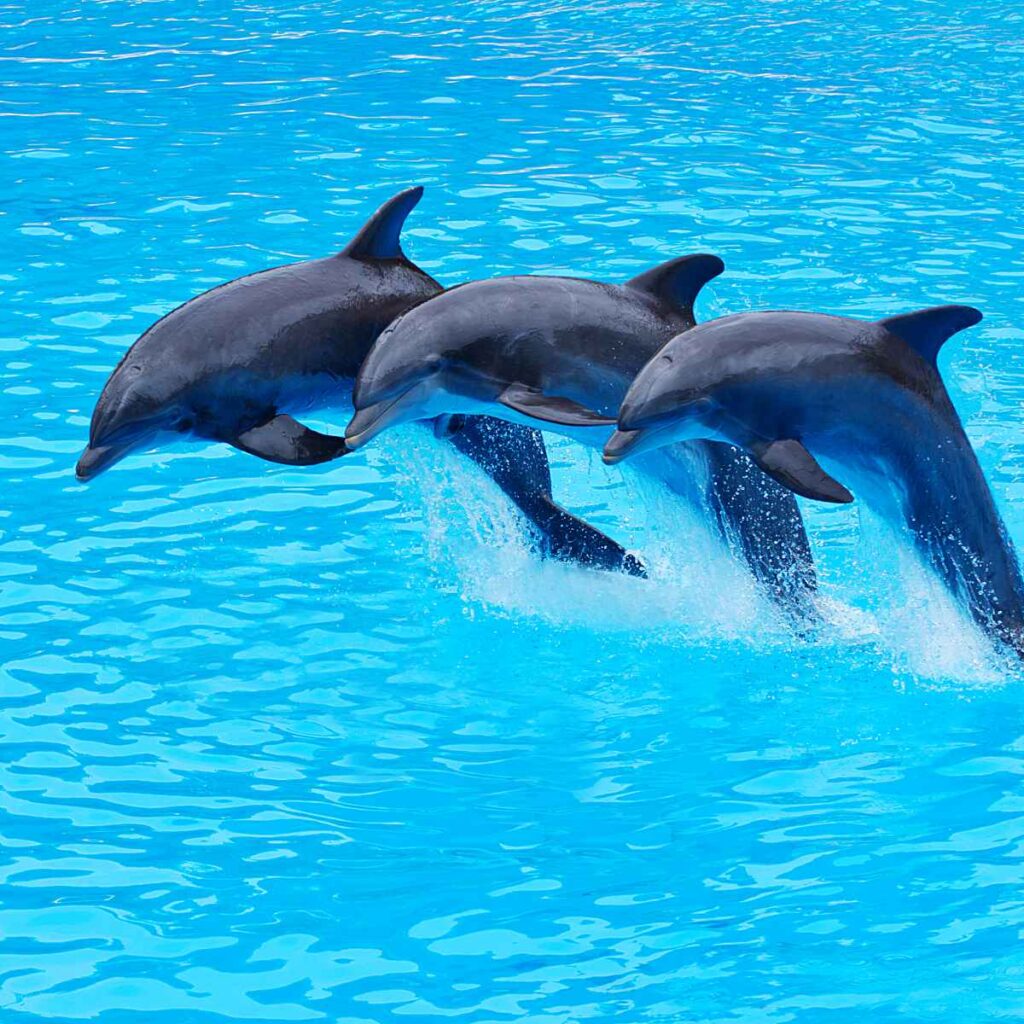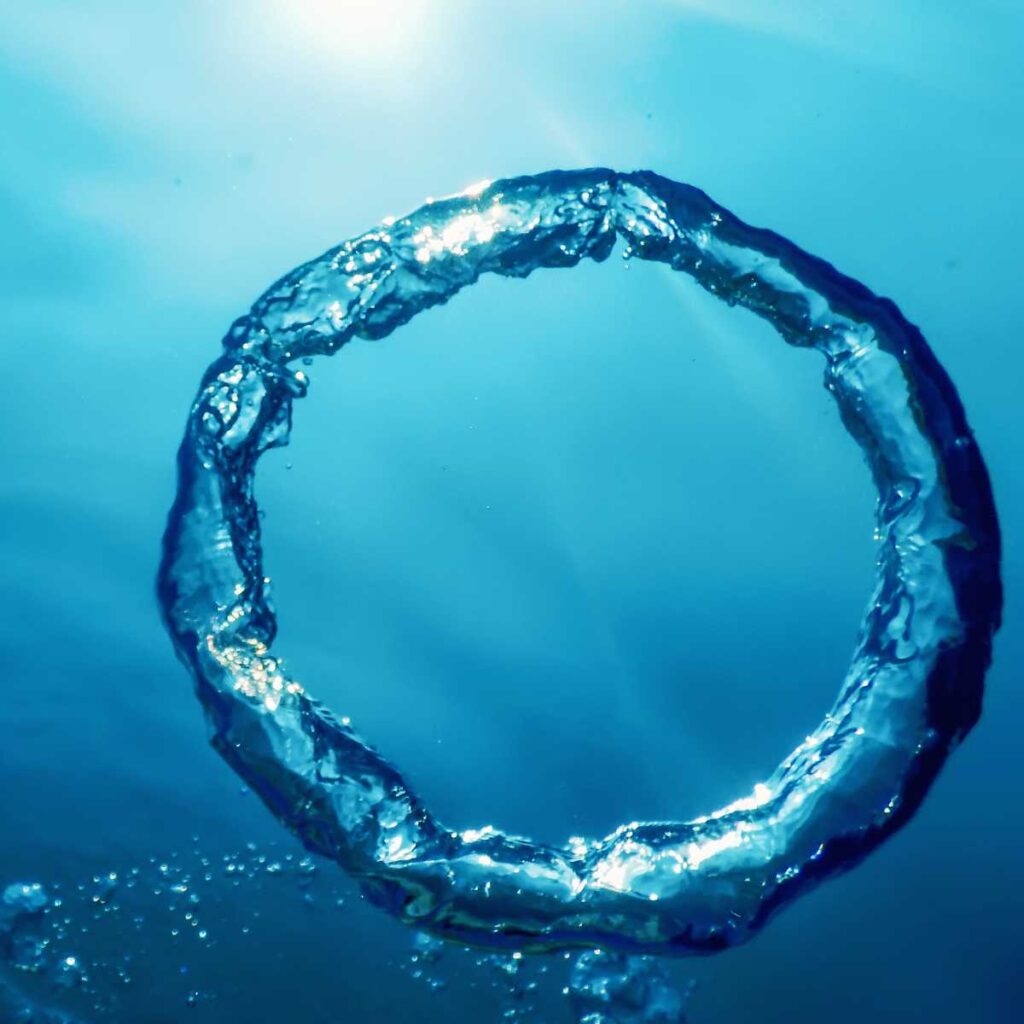Last Reviewed and Updated on January 25, 2023
Dolphins are some of the most fascinating creatures in the animal kingdom; they impress us with their intelligence, playfulness, and behavior. Let’s dive into some fascinating facts about dolphins that will make you appreciate them even more! Learn about how they show off their smarts and how they find food in the wild, as well as other incredible things about these majestic creatures.

About Dolphins
Dolphins are a group of marine mammals belonging to the family Delphinidae.
Most dolphins are saltwater mammals, and they can be found in oceans worldwide.
There are 40 known living species of dolphins. Some of the most well-known dolphin species include the bottlenose dolphin, common dolphin, orca, and spotted dolphin.
Dolphins are well suited for life in water. They have powerful tail fins that propel them through the water at high speeds. Their dorsal fins help them maintain their balance and direction while swimming.
All dolphins are carnivorous (they eat other animals), though their preferred food varies from species to species; some only prey on smaller fish and animals, while others can tackle larger prey.
On average, a female dolphin will give birth to one live young, sometimes twins. As they are mammals, the young stay with their mother and feed on their mother’s milk until they become independent.
Facts About Dolphins
Now let’s look at some of the most impressive and interesting facts about dolphins.

1. Some dolphins live in saltwater, and some in freshwater
Kicking off this list of facts about dolphins is the fact not all of them live in saltwater. When you think about dolphins, the first habitat that comes to mind is usually the ocean. However, dolphins live in the freshwater too.
Four species of river dolphins live in the Amazon river.
2. Dolphins are mammals and need to surface to breathe air
Dolphins are one of the few species of marine mammals. They have lungs and need to surface to breathe air. They are also warm-blooded and give birth to live young, which feed on their mother’s milk.
3. Dolphins don’t chew their food
They have teeth but use teeth only to break food into smaller pieces which they swallow whole. Dolphins feed on fish, squid, and crustaceans.
4. Spinner dolphin has 240 teeth
The number of teeth varies between dolphin species. Bottlenose dolphins have anywhere from 72 to 104 teeth. Risso’s dolphin has the least teeth of all dolphin species; 14. The absolute winner is the Spinner dolphin with 240 teeth.
5. Orcas are the largest dolphin, and Hector’s dolphins are the smallest
The largest dolphin species are orcas, also known as killer whales. Male orcas typically range from 20 to 26 feet / 6 to 8 meters, and females from 16 to 23 feet / 5 to 7 meters.
Hector’s dolphin is the smallest dolphin species; mature adults have a total length of 3 feet 11 inches to 5 feet 3 inches / 1.2-1.6 meters (with females being longer than males).
6. Adult Amazon river dolphins gradually become pink

Pink dolphins? Yes, please! Pink dolphins, also known as Amazon river dolphins or boto, are a species of freshwater dolphins found in the Amazon river and its tributaries in South America. They are born gray and gradually turn pink as they mature. Males are more prominently pink than females are.
7. Dolphins are the fastest marine mammals
The common dolphin (delphinus delphis) holds the title for the fastest marine mammal, reaching speeds higher than 20 mph / 32 km/h. Most of the time, they do swim at a slower pace at about 5 miles per hour / 8 km/h.
8. Some dolphins can use tools
Tool use in various degrees has been observed in some animal species, most commonly in primates and corvids (crows…). Some dolphins, too, can use tools in the wild.
Some populations of bottlenose dolphins in Shark Bay, Western Australia, use basket sponges as tools to forage for food. Female dolphins in this population pass the sponges down to their offspring, and the behavior has been passed down through generations.
Dolphins are considered one of the most intelligent animal species on Earth; they are known for their problem-solving abilities and complex social behaviors. The use of tools by dolphins indicates their cognitive capabilities and is considered an important aspect of their intelligence.
9. They recognize themselves in the mirror
Dolphins have been observed to exhibit self-awareness when they were introduced to a mirror.; this is something that is rarely seen in the animal kingdom.
In one study, two bottlenose dolphins were exposed to reflective surfaces (mirror), and both dolphins showed responses consistent with the use of mirrors, as with humans and some great apes.
10. Dolphins get high on Puffer-fish
There have been reports of wild dolphins intentionally seeking out and eating puffer fish, also known as blowfish, which contain the neurotoxin tetrodotoxin. This substance can cause hallucinations and a trance-like state when consumed in large enough quantities.
11. When sleeping, they shut off half their brain
Dolphins, like all mammals, need to sleep in order to rest and restore their bodies and minds. However, unlike most mammals, dolphins are conscious breathers, meaning they must actively control their breathing while sleeping. If their brains shut off while sleeping, they would cease breathing. To avoid this, they shut down only half of their brain at a time while the other half remains active.
This also allows them to be mindful of danger while asleep.
12. Dolphins use echolocation
They use echolocation to navigate and locate objects in their environment.
Echolocation is a biological sonar system that allows animals to emit high-frequency sounds; in the case of dolphins, clicks and listen for the echoes that bounce back from objects in their environment.
Dolphins produce this sound in the special structure in their head called the melon and receive it back and analyze it. By analyzing the echoes, dolphins can determine the distance, size, shape, and location of objects in the water.
13. They like to make air bubbles

They blow air bubbles and even make bubble rings. They make these bubbles on purpose; the bubble rings are most likely made for amusement.
14. The name dolphin means fish with a womb
The name is originally from the Greek “delphís,” dolphin, which was related to the Greek “delphus,” meaning womb. The animal’s name is thus interpreted as meaning “a ‘fish’ with a womb.”
15. Dolphins have two stomaches
One stomach is used for storing food, and the other for digesting it.
